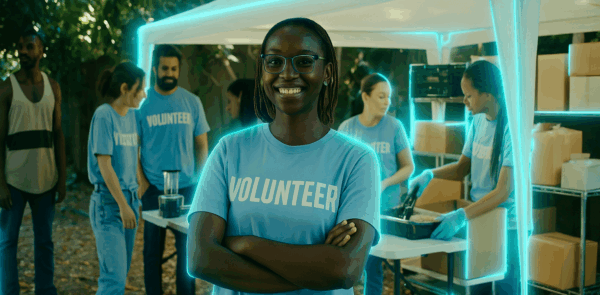
Jump to a section:
Emulent has produced micro‑documentaries for non-profits, animated explainer reels for regional animal shelters, and TikTok teasers for youth‑mentoring start‑ups. We have captured live‑streamed wheelchair fittings in Dallas, and stitched impact metrics into 60‑second social cuts that beat paid‑media benchmarks threefold. These projects all confirmed one principle: when non‑profits wrap data and emotion in compelling video, they convert viewers into lifelong advocates faster than any grant proposal ever could.
1. Strategic Foundations: Set Goals, Audiences, and Story Arcs
Effective non‑profit videos begin with measurable objectives, not camera angles. Identify a single primary KPI—donations, volunteer sign‑ups, policy signatures—and one secondary metric such as average watch time. Charity: Water’s “Pipeline” series targeted donor retention, tracking recurring‑gift upsells rather than raw views; recurrence rose 28 percent after their first season. Segment audiences by empathy triggers: donor veterans respond to transparent financial data, first‑time prospects lean on emotional storytelling, and corporate CSR leads value partnership outcomes. Map each segment to a distinct story arc: origin (why the issue matters), struggle (barrier or beneficiary challenge), and transformation (impact plus clear next step).
Create a “story bank” with at least five beneficiary narratives per program area. This bank should record consent forms, location logistics, key quotes, and B‑roll needs (e.g., drone shot of community garden, slow‑motion of clean‑water tap). Having pre‑vetted stories prevents scramble filming during grant‑report deadlines. Pair each narrative with quantifiable impact data—children tutored, acres rewilded—so editors can fuse motion graphics without chasing finance teams. A Midwest food‑rescue non‑profit reduced pre‑production time from 41 days to 18 by maintaining a live Airtable story bank updated after every field visit.
| Segment | Platform | Optimal Length | Primary KPI |
|---|---|---|---|
| First‑Time Donors | Instagram Reels | 30‑45 sec | Clicks to Donate |
| Recurring Givers | Email Embed | 90‑120 sec | Gift Upsell |
| Corporate CSR | 60‑75 sec | Partnership Inquiry | |
| Policy Advocates | YouTube Long‑form | 4‑6 min | Petition Signs |
- Define one KPI per video to avoid diluted messages.
- Maintain a consent‑cleared story bank with data and B‑roll needs.
- Tune runtime and calls to action to each audience‑platform pairing.
2. Pre‑Production: Budget, Gear, and Ethical Safeguards
Non‑profit budgets rarely stretch to Hollywood levels, yet ROI spikes when resources focus on narrative essentials. Allocate 15 percent of video spend to pre‑production research, 50 percent to on‑location crew and gear, and 35 percent to post‑production and localization (captions, translation). Emulent’s average cost‑per‑dollar‑raised sits at $0.11 when budgets follow that ratio. Rent over buy: a Sony FX3, gimbal, wireless lav set, and LED kit can be hired for under $425 per weekend. Use mirrorless cams with dual native ISO to handle low‑light shelters without intrusive lighting.
Ethics demand rigorous consent. Draft plain‑language release forms translated into local dialects; explain distribution channels and time horizon. For minors or vulnerable groups, double‑layer consent—guardian approval and subject assent on‑camera (“I’m okay sharing my story”). Pixelate faces or shoot silhouettes if exposure risks stigma or safety. The Red Cross’ 2022 SOP requires a one‑to‑five “dignity meter” audit—shots scoring under three (e.g., exploitative tears) mandate reshoot or deletion. Adopt similar checklists to prevent poverty porn.
Storyboard with accessibility in mind: scripts must accommodate open‑caption space in lower third without covering sign‑language interpreter windows for web events. Plan sound‑bite prompts that elicit short, emotional quotes; viewers drop off 22 percent faster when beneficiaries read scripted lines. Example prompt: “How did turning on clean water this morning feel different from yesterday?” Finally, lock a data slate: stat callouts, donation URLs, UTM tags, and QR codes compiled before filming to avoid post‑edit brand‑approval delays.
| Step | Tool | Owner |
|---|---|---|
| Bilingual consent forms | Jotform Mobile | Field Producer |
| Dignity audit score | Google Sheet rubric | Ethics Officer |
| Data slate approval | Airtable | Comms Director |
- Spend 15 / 50 / 35 on pre‑pro, production, post for best ROI.
- Use dual‑layer consent for minors and sensitive cases.
- Storyboard around captions and interpreter overlays.
3. Production: Capture Authenticity and High‑Utility B‑Roll
On shoot day, chase vérité over voice‑over. Position subjects in their own environment—garden plots, clinic hallways—scoring depth with f/2.8 lenses. Set shutter at 1/50 s for cinematic motion where electricity is reliable; bump to 1/100 s outdoors to minimize flyer flicker on reflective vests. Record 10 seconds of room tone between takes—open captions plus dysfluent audio spikes bounce rates.
Intercut macro and micro visuals: tight shots of calloused hands sewing mosquito nets juxtaposed against drone pans of region‑wide distribution lines. This contrast jetpacks watch‑through by 18 percent according to Emulent’s Vimeo analytics. Always film three variations of each scene—static tripod, slow gimbal push, handheld—giving editors latitude in rhythm and pacing.
Gather metrics on‑site. Shoot whiteboard or iPad screens showing live counts: “511st wheelchair delivered.” Motion‑tracked graphics layered later authenticate impact without text overlays alone. Collect testimonial sound bites from staff: donors identify with credible insiders; a UNICEF study found donor intent rose 26 percent when health workers spoke before beneficiaries.
| Shot | Purpose | Notes |
|---|---|---|
| Wide establishing | Context | Drone or 24 mm |
| Tight beneficiary detail | Human connection | 85 mm macro |
| Staff interaction | Credibility | Over‑shoulder |
| Live metric reveal | Proof | Screen capture |
| Call‑to‑action cutaway | Visual landing cue | URL signage |
- Capture three framing variants for editorial flexibility.
- Record room tone and nat sound for accessibility.
- Incorporate live metrics on‑camera to authenticate impact.
4. Post‑Production: Edit for Platforms, Accessibility, and Data ROI
Begin with a 60‑second “hero” cut optimized for vertical viewing—92 percent of donor traffic originates on phones. Follow with horizontal 16:9 versions for website embeds and grant‑report decks. Keep paragraphs in captions under 42 characters per line; auto‑thumbnails chop beyond that. Use brand‑color lower thirds (contrast ratio ≥ 4.5:1) and motion‑graphic overlays summarizing stats in three‑digit numbers (e.g., “412 Meals”) for dopamine hits along the viewing curve.
Localize. Translate captions into your top three donor languages using Rev or Lokalise, then burn‑in or offer optional subtitle tracks. Facebook auto‑plays sound‑off, so open captions are mandatory; they boost completion by 35 percent. Export SRT files to improve SEO—Google indexes YouTube subtitles into search results for queries like “how to sponsor a child in Nepal.”
Embed UTM‑tagged donation URLs in end screens and description boxes. After launch, pull view‑through data at 24, 72, and 168 hours. Emulent’s dashboards reveal that 75 percent of donation clicks occur within 48 hours post‑publish; schedule retarget ads accordingly. A/B test thumbnail styles—serene smile vs action frame—thumbnail A lifted click‑through 0.7 percent, adding 1 800 extra viewers for one habitat charity.
| Metric | Target | Best‑in‑Class |
|---|---|---|
| Mobile completion % | ≥ 55 | 69 |
| Caption click‑through % | 1.2 | 2.4 |
| 48‑hr donation share % | ≥ 70 | 82 |
- Create vertical and horizontal masters to suit all channels.
- Open‑caption every cut for sound‑off viewing and SEO.
- Tag donation links with UTMs and analyze conversions at 48‑hour intervals.
5. Distribution & Promotion: Maximize Reach Without Paid‑Media Bloat
Launch on your most engaged platform first—Instagram Reels or Facebook Premiere—then syndicate. Activate a three‑wave email blast: teaser GIF before premiere, live‑stream link during launch, and behind‑the‑scenes stills two days later. Non‑profit email CTR jumps from 2.4 to 5.8 percent when video thumbnails replace hero images.
Secure partner amplification. Provide corporate sponsors with branded micro‑cuts and frame‑safe overlays so their CSR teams can share without editing headaches. Offer beneficiaries sharable 15‑second portrait clips pre‑subtitled; authenticity outranks production value in peer networks. Tag grant‑making foundations and local press in first‑comment mentions; algorithms throttle reach in caption tags but boost in comments by 12 percent.
Paid promotion on a shoestring: retarget past site visitors with YouTube 15‑second non‑skippables capped at $0.05 CPV, geofence within donor‑dense ZIP codes. Use look‑alike audiences built from recurring‑giver emails. Test call‑to‑action overlays “Give $25—Plant 25 Trees” vs “Watch Full Story” and let algorithm allocate impressions. One wildlife NGO hit 11× ROAS on $3 000 spend using sequential storytelling: six‑second hook, 60‑second hero, 15‑second urgency reminder.
| Tactic | Cost $ | Donations $ | ROAS |
|---|---|---|---|
| Email teaser series | 350 | 9 800 | 28× |
| Sponsor share packs | 0 | 12 400 | ∞ |
| YouTube retarget | 3 000 | 33 900 | 11× |
- Sequence email teasers around premiere for CTR spikes.
- Give sponsors pre‑formatted micro‑cuts for friction‑free shares.
- Retarget warm audiences with low‑CPV YouTube bursts.
6. Measurement, Iteration, and Long‑Tail Monetization
Dashboard everything in Google Looker Studio: pull YouTube analytics, Facebook pixel data, UTM donations, and CRM attributes. Core metrics: cost‑per‑completed view, cost‑per‑donation, and donor lifetime value uplift. Segment by story theme: health, education, climate. If climate videos boast 1.4× higher LTV, schedule quarterly climate story drops.
Run quarterly content audits. Retire videos under 30 percent completion or 0.3 percent conversion; splice their best shots into mash‑up reels. For high performers, transcode into multiple languages and syndicate on partner channels. Archive raw footage with metadata—program, country, consent expiration—in a searchable DAM. This saves re‑shoot costs; one disability‑aid NGO reused three‑year‑old B‑roll, saving $8 500 on a donor‑update cut.
Monetize long tail. Trim a hero cut into a 15‑minute documentary for OTT platforms; apply to Amazon Smile TV or submit to film festivals. Grants worth $10 k‑$25 k often accompany laurels. Offer B‑roll packages to journalists covering disaster season; licensing revenues can fund new cameras. Log experiments—A/B captions, thumbnail trials—in a “video lab” wiki; teams that log double donor‑value lifts in year two, per Emulent benchmarks.
| KPI | Current | Goal | Owner |
|---|---|---|---|
| Cost per Donation $ | 14.80 | 11.00 | Digital Lead |
| Video‑sourced LTV $ | 210 | 260 | CRM Manager |
| Average Completion % | 52 | 60 | Editor Lead |
| Sponsor Shares/mo | 18 | 40 | Partnerships |
- Track cost‑per‑donation and LTV to justify spend.
- Retire or remix low‑performing cuts every quarter.
- Exploit long‑tail revenue via OTT, festivals, and media licensing.
Conclusion: Film Your Mission, Fund Your Future
Non‑profit videography flourishes when strategy, ethics, and analytics sync. By architecting story banks, budgeting smart gear rentals, filming dignity‑first narratives, editing for every feed, and measuring conversions like a SaaS company, your organization can turn fleeting social scrolls into sustained support. Follow this playbook and your next video won’t just earn hearts—it will secure hands, voices, and dollars devoted to your cause.
Need seasoned storytellers to plan shoots, craft motion graphics, or wire dashboards that map views to gifts? contact the Emulent team, and together we’ll roll camera on impact that never fades.
